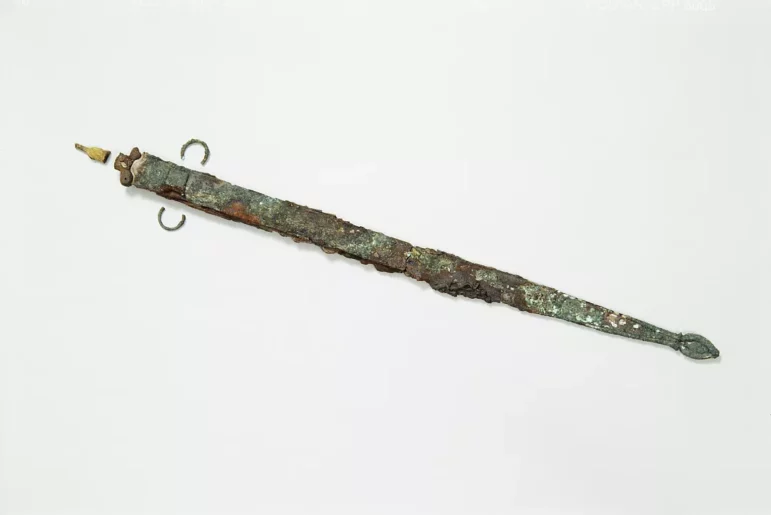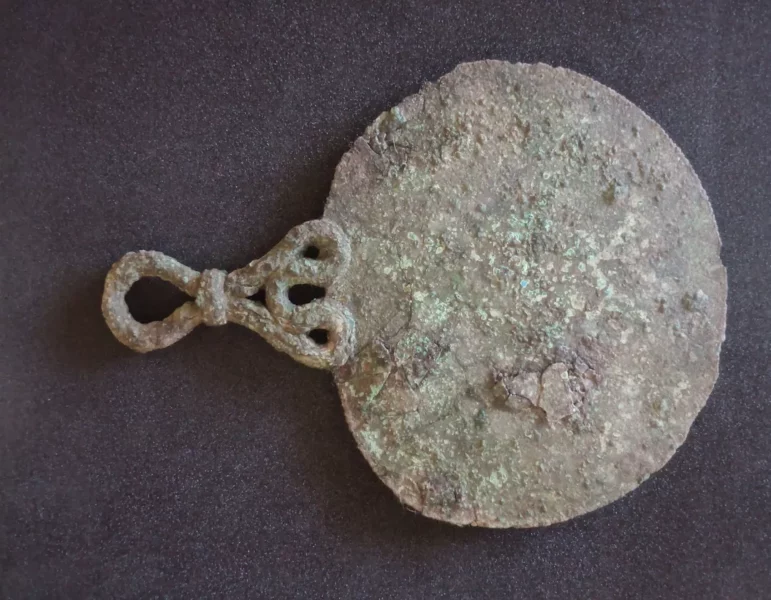LONDON – The inhabitant of a 2000-year-old grave in the Scilly Isles off the Cornish coast has been revealed to be female, archaeologists reported recently. The grave, discovered in 1999, is an interesting find as it contains a copper alloy scabbard and a sword and shield, but also a brooch and a bronze mirror.
The body itself had long since decayed but advances in forensics have meant that the sex of the skeleton has been able to be determined via analysis of proteins in the tooth enamel.
Dr. Sarah Stark, a human skeletal biologist at Historic England, told the Guardian newspaper that the findings provided “evidence of a leading role for a woman in warfare on iron age Scilly. Although we can never know completely about the symbolism of objects found in graves, the combination of a sword and a mirror suggests this woman had high status within her community and may have played a commanding role in local warfare, organising or leading raids on rival groups. This could suggest that female involvement in raiding and other types of violence was more common in iron age society than we’ve previously thought, and it could have laid the foundations from which leaders like Boudicca would later emerge.”

Boadicea Haranguing the Britons [John Opie- Public Domain]
However, this hypothesis has proved contentious with our regular Wild Hunt contributors:
“Grave goods are status indicators. Weapons are high status. This lady was undoubtedly important and socially powerful but projecting modern ideas onto ancient peoples is dodgy.” (John Lambshead, biologist, historian and author of The Fall of Roman Britain: and why we speak English).
“…it is tedious. Wonder if the categorisations often stated such as ‘witch, princess, priestess, female warrior’ are for catchy press release purposes, to get publicity which can get funding? Just thinking out loud. It can’t tell us much about Iron-age warfare if it is one isolated high-status grave. I dislike the oft applied ‘they were just like us!’ stuff too. (Caroline Wise, esoteric writer)
“This rang a bell, and I find I have read an article on the same discovery, dated 2016, before the bone fragments were identified as female, where the author described the skeleton as “unsexable” but was intrigued by the presence of sword (gendered “male”) and mirror (gendered “female”). But also raised the question of whether in these burials we identify the mirror as “meaning” feminine because it is found with a female skeleton and identify a skeleton as female because there is a mirror with it (circular reasoning?). And the same article noted that “East Yorkshire burials containing martial equipment (one with a sword and one without) have been identified as containing the remains of women”, and cast doubt on the firmness of the identification of “mirrors” with female graves, noting the shamanistic role of mirrors and that finding mirrors as part of grave goods does not necessarily correlate with the presence of other “feminine” grave goods (beads, rings, toiletry items). To put it more briefly, yes it could be as the article suggests but there could also be stuff going on that we don’t really know about.” (Andy Sawyer, librarian, critic and academic)

A sword found in a 2,000-year-old Iron Age burial on Bryher, the Isles of Scilly, just off the coast of Cornwall [Credit: The Historic England Archive, Historic England
“’The Red Lady of Paviland’ was identified as female for quite a while on the strength of beads being found amongst his grave goods…” (Tina Rath, writer)
“Each burial they re-examine confirms to me that whatever society ancient peoples had, they apparently had ways to allow members to use their abilities for their communities. And then those people were honored in some way at their burial. I also see just how much Pauline Christianity and patriarchy, and other patriarchal religions, may have stolen from our resiliency as a species. Hope the next generations realize this and move on from those restrictions. (Katharine Eliska Kimbriel, writer)

A bronze mirror was found in a 2,000-year-old Iron Age burial on Bryher, the Isles of Scilly, just off the coast of Cornwall, England. [Photo Credit: Isles of Scilly Museum Association]
“The medical biologist interviewed in the article is talking [nonsense]. There’s no evidence for the use of mirrors in the ways she suggests (and anyway a bronze mirror wouldn’t be suitable for signaling). All we can say for certain is, as John said, that this woman was of high status. The gendering of grave goods is based on modern assumptions about gender and roles; the perpetual search for “women warriors” and the perception of same as somehow better or more important is rooted in toxic patriarchal ideas about value anyway. And as such it’s inherently misogynistic, because it depicts so-called ‘male’ roles and attributes as somehow better than those we currently consider female. It’s a model of analysis that needs to be critiqued hard, frankly. And newspapers need to stop citing people as experts on subjects outside their field of expertise.” (Dr. Kari Sperring, historian and novelist).
The Wild Hunt is not responsible for links to external content.
To join a conversation on this post:
Visit our The Wild Hunt subreddit! Point your favorite browser to https://www.reddit.com/r/The_Wild_Hunt_News/, then click “JOIN”. Make sure to click the bell, too, to be notified of new articles posted to our subreddit.
